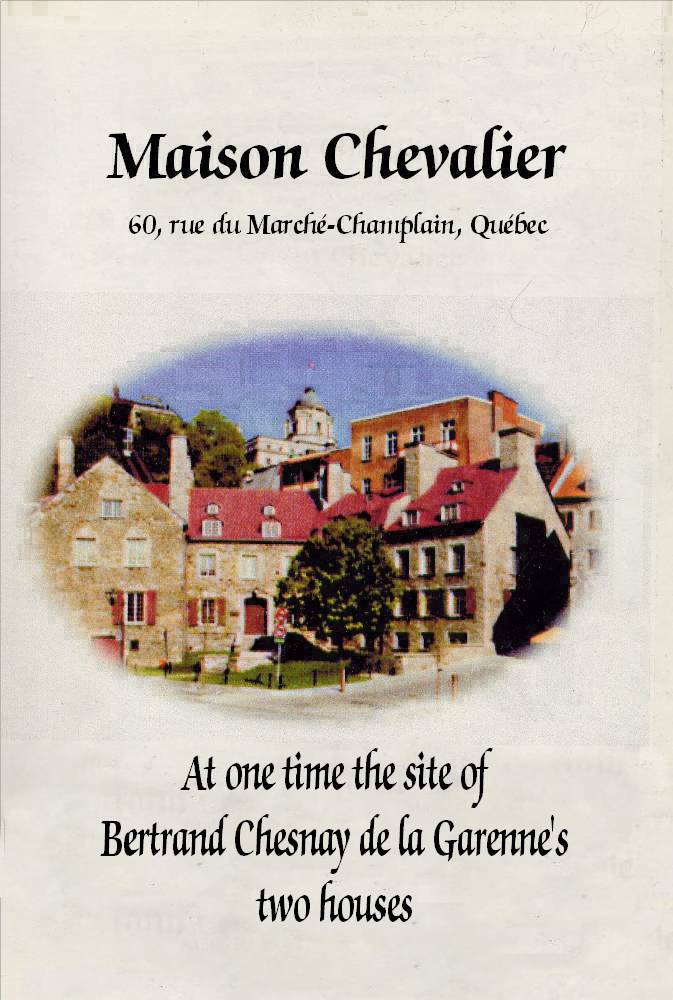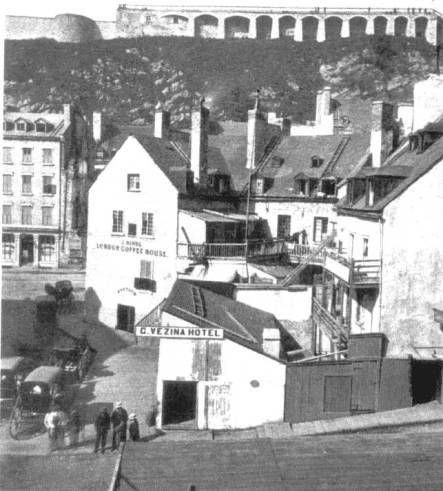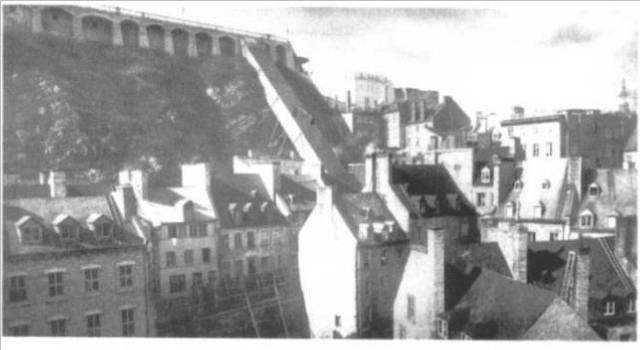


Québec, around 1994
(© Copyright: Irving Weisdorf & Co. Ltd, Markham, Ontario)

Hotel Chevalier
Three Houses In One
Text drawn from volume I "Les Chemins de la Mémoire" (Québec Publications)
Integral part of the historic site of Place-Royale and restored in 1959 by the Commission of Historic Buildings, which one finds today under the name of Chevalier house is actually three distinct houses: the Chesnay house, (2291) the house Frérot (2290) and the house Knight (2289).
Located at the corner of Cul-de-Sac and Notre-Dame streets, the Chesnay house was entirely rebuilt at the time of work of restoration of this architectural unit. It was Bertrand Chesnay de la Garenne, a merchant, who created the original house (2291) in the XVII century.

It is this same Chesnay who, a few years earlier, had built the house located at the centre of the Chevalier unit, (2290) before ceding it to Thomas Frérot. Indicated today under the name of its second owner, it is the oldest component of the unit.
H
ôtel Jean-Baptiste Chevalier60, rue du Marché-Champlain, in Québec

L'hôtel Chevalier, around 1865
(© Copyright: McCord Museum, Notman Photographic Archives)
The architectural unit, opening on the Champlain market place and known under the name of "Hôtel Chevalier" marks the beginnings of the history of the institutional architecture, where Place-Royale and the historical district of Old Québec began.
Composed of four buildings, Hotel Chevalier covers three cadastral divisions of Champlain. Lot 2289, most to the west, occupied by two perpendicular main buildings, constitutes the Chevalier house itself; lot 2290, occupied by a house with a mansard roof, is known as the house Pagé or Frérot; finally, a building partly rebuilt in 1958-1959 in the style of the nearby buildings was built on lot batch 2291.
These buildings were built at the Cul-de-sac, formerly a kind of natural basin delimited on the bank of the St. Lawrence at the point of the cape and and Pointe-aux-Roches. Since the time of Champlain, the inhabitants have use this small waterfront port for boats. This "open basin which is dry with each tide", according to a definition by Joseph Bouchette (1815), yields his place to the Champlain market at the XIX century. Also, until about 1800, only the Cul-de-Sac street gives access to the buildings forming part of Hotel Chevalier where their frontages are drawn up; the court of honour, which emphasizes the current entrance, constitutes actually the rear facade of these four main buildings where galleries originally existed.
The Chevalier house itself is the result of a series of successive work campaigns on lot 2289. In 1675, Jean Soulard, the King’s "arquebusier", constructed a house of two floors measuring 14 by 6 meters. The fire of 1682 in the lower-city, destroyed this structure, and the following year Soulard rebuilt a larger house. Two years before hi death, which has occurred in 1710, he created other works of importance. A little while later Jean Gastin dit Saint-Jean acquired the house. It then measured 9,8 by 15,3 meters. He then added an extension on the west side in 1719, and rented a part of the house to a landlord.
In 1735, the building was owned by François-Étienne Cugnet, a Paris lawyer and merchant and contractor in Nouvelle-France. Living on Saint-Pierre Street, Cugnet uses this building for its many commercial activities. Member of the Saint-Maurice forging mills and ship-owner, he has important interests in fur trade and Canadian tobacco exports. Placed into bankruptcy in 1741, Cugnet maintains the possession of his goods until his death (1751), but seemed to neglect the house located at the Cul-de-Sac, a refurbished area from 1748 to 1750 for maritime building sites granted by the King. Also, in 1752, Jean-Baptist Chevalier acquired land on which "walls in ruin are only found". It may be that the house was the destroyed by fire some time before, but no document exists to prove this.
Merchant and ship-owner, Jean-Baptist Chevalier at the age of 37 has a relatively considerable fortune at the time when he acquires this property. He retains the services of Pierre Renaud dit Canard, master mason and contractor, to ensure construction of a new dwelling, formed from the two main buildings. Renaud must use a part of existing masonry, in particular the foundations and the pinion walls. Jean-Baptist Chevalier hardly benefits from his new residence, completed in 1753. During the seige of Quebec, a fire devastates it. Relocating his business at La Rochelle before the conquest, Chevalier however, occupies himself to restablish his house. He entrusts this task to Pierre Delestre dit Beaujour, architect, master mason and contractor, who organizes the building site with the help of Charles Gignac, carpenter, and Jean Janson dit Dauphiné, carpenter. The new building is almost identical to the existing one today. The interior doors and the ornate interior wardrobes built with curved outlines recall the late (1760-1780) style of Louis the XV period.
At the death of Jean-Baptist Chevalier in La Rochelle in 1769, Jean-Louis Frémont becomes the new owner of the building and all its contents. In 1780, the residence with "its arched cellars, quite convenient and very good for the conservation of the effects and safe from fire" is sold through biddings, following the bankruptcy of the merchant who had taken refuge in Paris. In 1807, George Pozer, a great landowner of Quebec, known as "the first Quebec millionaire", buys the Chevalier house, which become an investment property. Throughout the XIX century, people of Quebec knew it as the London Coffee House, and several watercolours by James Pattison Cockburn created in 1829-1830 illustrates this.

The London Coffee House in 1830, from a watercolour painting by James Pattison Cockburn
(© Copyright: Royal Ontario Museum)
On lot 2290, next to the Chevalier house, in 1662 the first two story house was built out of wood. It was burnt in the lower city fire of 1682. Thomas Frérot, acting in the name of the succession of Bertrand Chesnaye of Garenne, took care of its reconstruction the following year. Rebuilt out of stone a little after being occupied by the goldsmith Joseph Pagé dit Quercy, the building passed into the hands of the navigator Joseph Chabot, who carries out work in 1758. After the conquest of Québec, the owner again carries on with the reconstruction of the building. Apart from the repairs carried out by Guillaume Roi in 1811, no other trace of subsequent work can be found. However, on the walls of 1761, is a mansard type roof by its form and also by the technological use back in the 1880's.

About 1880, Lower Québec city still offered a rather homogeneous image of buildings where certain types of architecture persisted throughtraditional practices. As seen here and on the right & forefront the restored house now known as "L'hôtel Chevalier"
The history of the occupation of the third lot is less interesting because only little of traces of the original building remains. Already, in 1662, a house is built on this site. In 1683, Étienne Thivierge built a house and, in 1713, a beautiful stone residence with a mansard type roof appears in the name of Dolbec. After the conquest, the house, now belonging to Lady Urquhard, undergoes probably certain modifications. Starting from the dividing walls of this building, visible in photographs of 1865-1870, a new brick construction of four stories appears in 1901. The following year a second building is set up on the same lot, but it face more towards the Champlain market. The owner of the three lots, Pierre Godbout uses his buildings for commercial purposes and warehouse
In 1949, the director of the works of arts inventory, Gerard Morisset, becomes interested in the building’s architecture. His literary work, "Achitecture en Novelle France" indicates that the Chevalier house dates from the French regime, that it was rebuilt about 1770 and that its architecture is "d'esprit roman". Using the research done by Morisset for a report submitted to the Secretariat of the province, Jean Bruchési attracts public attention on this monument. In 1955, acting as secretary of the Commission of the historic monuments, Morisset returns and forges ahead to defend the cause of what is called Hotel Chevalier; at this time, he has at hand the task of construction established in the name of Jean-Baptist Chevalier in 1752 and praises the architectural qualities of the original building from a negative by photographer Louis-Prudent Valley.
The Commission of the historic monuments, maintained and renewed by the law of 1952, met for the first time on 10 May 1955 and undertook to clear the many files accumulated during these three years. On 13 Sep 1955, it recommended to the Premier, Maurice Duplessis to purchase the Chevalier house and to restore it; it wished to establish an "arts & craft museum", a branch of the Museum of Québec. This acquisition was made on 11 May 1956 in virtue of an amendment to the constitution laws of the Commission, adopted previously on 22 February.
Established in 1956, the occupation program under consideration by the Commission provides that the museum will be located on the ground floor and at the junction of the two main buildings of the Chevalier house, that the Pagé house will shelter the office of the Commission and that a guard will remain in the newly renovated building.
This ambitious program largely hinges around the particular concept of the hotel, borrowed from the history of french architecture of XVIIe and XVIIIe centuries by Gerard Morisset. Ignorant of the fact that the Chevalier house constituted a double dwelling occupied by three families, Morisset envisions a private mansion, a building made up of several main buildings and divided into apartments - a series of managable show places and conveniences - and service. The parisian hotel being set up around a court of honour, recommends utilizing the back frontage facing the river for this purpose; it is sufficient to re-orientate the frontages towards the Champlain market where a principal entrance would be established to show the effects of this monument’s research.
Responsible for the restoration, the architect André Robitaille submits a model on 7 June 1957: this one respects the plans of Morisset. Work begins and very quickly a problem is recognised on the building lots 2290 and 2291. The Commission decides to preserve the Pagé house with its end of the XIX century roof, to allow to rebuild part of the nearby building (lot 2291). The Commission nevertheless must wait five years before the commercial owner of the building located in front of the lot 2291 before he accepts it to his full liking.
The particular concept of hotel and the mode of restoration considered - the return to its original state - testify to omnipresence of the french model for this first incursion of the province of Québec into the field of architectural conservation. Already, in several former texts, Gérard Morisset was defined as a follower of the restorations of Viollet-le-Duc, father of the stylistic restoration for which "to restore a building is to restore it in a complete state which can never have existed at a given time". The spirit of the state of restoration explains the resurrection of the house of lot 2291, house accompaniment - or couteous architecture according to the vocabulary used in France - and the reorganization of the frontages, all in order to create Hotel Chevalier. This operation evokes, of course, the example of Sully Hotel in Paris, restored at the same time to be used as the seat of the Commission for the historic monuments buildings of France.
Already described in detail by Andre Robitaille, the restoration of Hotel Chevalier constitutes one capital moment of the history of the architectural conservation in Québec. It marks an important stage in the recognition of the heritage buildings of Old Québec. The interest created by the restoration of "l’hôtel Chevalier", between 1955 and 1962, truly allowed the lower Québec city to escape the axes of demolition. From 1960, the Commission of the historic buildings declared itself satisfied with the repercussions of this building site; the Fornel house and Notre-Dame-des-Victoires church would follow, and consequently, the project to restore the buildings of Place-Royale and nearby streets were born.
The Hotel Chevalier occupies an advantageous place in history of Québec architecture. One finds of course the formal characteristics resulting of traditional practices established in contact with important monuments: broad pinion, large frames and arched cellars; but it is especially about a building which, in spite of the rules and regulations, escaped from the characteristic uniformity of habitation of the years 1740-1780 by its establishment on a completely particular site, which explains the openwork pinion and the multiple main buildings.
The Hotel Chevalier owes its prestige to this site, its original constructions and the many reconstructions to which the historical file testifies, with the quality of the various occupants in as much as the renaissance and rebirth of the building between 1955 and 1962. The building easily appears several centuries old, and in this capacity evokes it of being an historical building in the true sense of the meaning.

View of Hotel Chevalier with the four seperate units, the two buildings to the west constitute the Chevalier house
This article is © Copyright: LUC NOPPEN Architecural Historian